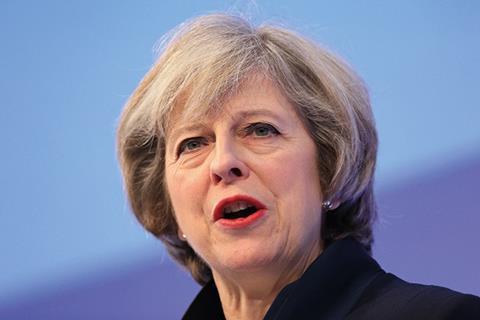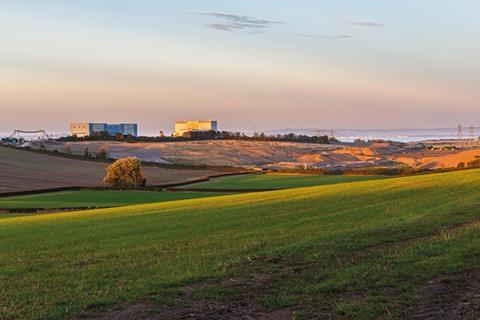ItŌĆÖs been a long time since the industry - and the country - has faced a year of such uncertainty. Joey Gardiner tries to make sense of it all while some key industry insiders tell us what they think will be the big talking points of 2017

Predicting the future has become an increasingly fraught and risky enterprise ŌĆō as any number of widely-derided opinion pollsters can testify. From the ToriesŌĆÖ 2015 majority, to the Brexit vote and the election of Donald Trump, any number of people who confidently told you what was going to happen in the last couple of years have ended up on the receiving end of a hell of a lesson in modesty.
║┌Č┤╔ńŪ° is not immune. Last year we kicked off by forecasting the London mayoral election to be the stand-out political event of 2016 ŌĆō important, sure ŌĆō but it feels like small beer next to the game-changing referendum decision and its fall out. Given the hefty dose of humility consumed by pundits in 2016, itŌĆÖs little surprise that the major point of consensus for this year ahead is for continued and deepening uncertainty, on both the political and economic level. Hence the Construction Products Association (CPA) refusing to make predictions beyond 2018 because of the lack of certainty over the trading conditions after exit from the European Union (EU).
At this point, the stand out UK political event of the year looks likely to be the triggering of Article 50 in the spring, after which the UKŌĆÖs future relationship with Europe may start to become clearer.
Nevertheless, by the end of the year it may actually be that the fallout from general elections in France, Germany and the Netherlands, where centrist parties are all facing growing ŌĆ£populistŌĆØ movements, does much more to affect the political climate and economic sentiment ŌĆō particularly if there are more 2016-style upsets.
The CPAŌĆÖs economics director Noble Francis, says: ŌĆ£Policy-wise it is difficult to ascertain what this disaffection of a significant proportion of the population means in practice but it will clearly increase uncertainty at a time when uncertainty, nationally and globally, is already high.ŌĆØ
Jack Pringle, London managing director at design firm Perkins + Will, says: ŌĆ£2017 could be politically the most turbulent year for a very long time ŌĆō which could wash into the economy. It will potentially be very volatile on the economic front.ŌĆØ
With Theresa MayŌĆÖs still very new government slowly defining (and seemingly inventing) its agenda as it goes along, while economists argue whether a Brexit-related economic slowdown has been avoided or merely postponed, there is much to be unsure of in 2017. Below ║┌Č┤╔ńŪ° does what it can to peek through the mistŌĆ”
Economy

The Office for Budget Responsibility has already revised down the overall UK growth forecast for 2017 year from 2.2% to 1.4%, while revising up inflation expectations in the wake of the 20% plummet in the value of sterling. For construction, most forecasters expect this to translate into non-existent or very weak growth in output, with the CPA predicting output overall to rise by just 0.3%.
However, things will look very different according to which sector you work in: the CPA expects infrastructure to show strong growth of more than 6%; housebuilding is expected to be flat, ending a run of four years of strong growth; commercial construction activity, particularly offices and possibly also retail, is expected to be weaker ŌĆō office construction output is forecast to fall 3% ŌĆō with the finishing off of existing schemes hiding a much weaker pipeline of new work coming through.
Richard Young, director at project manager Buro Four, says: ŌĆ£The big commercial schemes of above 200,000ft2; there arenŌĆÖt going to be many wanting to push the button on those.ŌĆØ
Analysts are divided, however, on the impact this weakening commercial market will have on construction prices, particularly given relative strength elsewhere. Simon Rawlinson, head of insight at consultant Arcadis, says tender prices in the London commercial market will drop 4-5% this year.
ŌĆ£We can be pretty certain about that,ŌĆØ he says. ŌĆ£ThereŌĆÖs been a slightly artificial level of confidence since the vote. But if thereŌĆÖs enough of a hiatus in new projects people will need to secure workload.ŌĆØ
However, Iain Parker, partner at consultant Alinea, says contractors and specialists have stronger current order books than many realise, and lingering financial worries from the recession mean most will avoid taking on low priced work ŌĆō at least until the second half of the year.
ŌĆ£We donŌĆÖt anticipate tender price cuts immediately. The more aggressive pricing hasnŌĆÖt come through yet, though we expect some to sharpen their pencils in the second half of the year,ŌĆØ he says.
In the meantime, rising costs may be more of a concern to contractors than falling tender prices, with largely imported products such as cladding and M&E plant hit by the drop in sterling. This has already led to an increase in the cost of imported products, says the CPAŌĆÖs Francis. ŌĆ£Rather than a lack of demand,ŌĆØ he says, ŌĆ£the key issue for construction in the next couple of years could well be cost inflation. In time the cost of UK manufactured products is also likely to increase as a consequence of international supply chains and energy price rises.ŌĆØ
Politics

While Brexit is set to dominate domestic politics overall, for the construction community the most eagerly awaited political event currently is the publication of the housing white paper, expected later this month. The white paper will tackle a vast array of issues related to housing supply, encompassing the future of social housing, Starter Homes, the build to rent sector, and planning reform. Specific measures are expected to attempt to prevent housebuilders from land banking and to reform the operation of the Community Infrastructure Levy. There is even some talk of the issue of reducing the VAT charged for housing renovation being back on the agenda ŌĆō dismissed for years by the Treasury, despite concerted campaigning, as being too difficult to do while within the EU.
Ian Fletcher, policy director for real estate at the British Property Federation, said he hoped the white paper would announce plans to embed build to rent within the UK planning system at a national level in a similar way as recently proposed by London mayor Sadiq Khan in the capital.
ŌĆ£A huge amount in policy terms lies on what happens this month,ŌĆØ says Fletcher. ŌĆ£WeŌĆÖre hoping for strong support for build to rent and weŌĆÖve also had indications theyŌĆÖre considering more resource for local authority planning departments.ŌĆØ
Housebuilders will want to know if government funding for housebuilding may in future be directing back toward social housing. Later in the year they will also be looking to see how hard Theresa MayŌĆÖs government clamps down on local authorities which have not produced local plans, with councils given a deadline of April to get their houses in order.
Regarding Brexit, the biggest concerns will be to what extent negotiations over leaving the EU will dampen economic growth, and the more specific issue of what future access UK firms will have to overseas workers to design and deliver UK construction projects.
Brian Berry, chief executive of the Federation of Master Builders (FMB), says: ŌĆ£We want clarity on how immigration will work post-Brexit. We just donŌĆÖt want anything to make exiting even more tricky.ŌĆØ
Partially related to this, the other big political issue for construction in 2017 will be training and apprentices. The governmentŌĆÖs large employer levy will start operating in April, forcing 900 firms to pay both that and the CITB levy, and there are concerns as to how it will operate. Former chief construction advisor Paul MorrellŌĆÖs review of industry training boards, which covers the CITB, will report at some point, though a time frame has not been given. This will determine the future operation of the industryŌĆÖs much-criticised levy to pay for apprentices. The FMBŌĆÖs Berry says: ŌĆ£The departure of the CITBŌĆÖs chief executive [Adrian Belton] at the end of last year could make it vulnerable under the review, so weŌĆÖre hoping for a quick transition to new leadership.ŌĆØ
On the infrastructure side, news is expected following the Autumn Statement pledge to announce a pipeline of PF2 private finance projects ŌĆ£earlyŌĆØ in the year. The governmentŌĆÖs infrastructure unit ŌĆō the Infrastructure and Projects Authority ŌĆō is also due to report on improving infrastructure productivity by the summer, and the National Infrastructure Commission will report on the use of new technology.
Projects

Strange to say in a time of supposed spending austerity, but many expect the impetus for major new projects this year to come from the public sector, with Theresa MayŌĆÖs government having given the go ahead to the three Hs ŌĆō Heathrow, Hinkley and HS2 ŌĆō in its first few months.
Contractors can expect work on Hinkley to ramp up quickly, while many of the headlines will be made by HS2, set to gain Royal Assent shortly. HS2 construction work is still slated to start this year, with ┬Ż9bn of main civils contracts to be let in the next six months. Meanwhile design work on Heathrow will speed up in preparation for the submission of a planning application in 2019.
At the same time, other public projects are being worked up for approval, with the business case for Crossrail 2 to be submitted to the Treasury later this year, and the ┬Ż7bn Palace of Westminster refurbishment still on the starting blocks. The ┬Ż369m refurbishment of Buckingham Palace, on which Sir Robert McAlpine has a role, is supposed to start in April.
ArcadisŌĆÖ Rawlinson says: ŌĆ£Some areas of the market feel quite strong. The government is being quite supportive of infrastructure and the likes of Thames Tideway and Crossrail 2 have momentum.ŌĆØ
However, the industry will be sharply alert to any delays in moving projects from the drawing board to the building site. ŌĆ£To ensure growth for the construction industry overall in the next few years, it is essential that the previously announced projects feed through into activity on the ground rather than focusing on new announcements,ŌĆØ says the CPAŌĆÖs Francis.
For many of the biggest building contractors, the spotlight will remain on private work, where the market is less certain. Many expect high end residential schemes that have not already been paused to come under threat, while funders are likely to think very hard about giving the go ahead to speculative office projects. The decision last year to push ahead with the 1.3 million ft2 22 Bishopsgate means construction should start there this year, but it could also make it harder for rival schemes to find tenants to anchor big new buildings. Hence there is much scepticism that schemes such as 1 Undershaft and 40 Leadenhall ŌĆō otherwise known as Gotham City ŌĆō will get moving. Buro FourŌĆÖs Young says: ŌĆ£ItŌĆÖs hard to see why an overseas investor would put 1 million ft2 in the City right now. IŌĆÖd be surprised if there was a lot of progress [on 1 Undershaft].ŌĆØ
Optimists, however, say investors and developers are finding other places to put their money. The BPFŌĆÖs Fletcher says: ŌĆ£The biggest ongoing issue will be the growing appetite to diversify in to other types of assets. If last year was the year of build to rent, the next two could be about providing for the elderly and their housing needs.ŌĆØ
Following on from last yearŌĆÖs Farmer report, the growth in use of off-site and prefabricated construction methods to build projects out is expected to continue.
Companies
For many in the construction sector, 2017 looks likely to be a harder year to navigate than the last. Kevin Cammack, analyst at Cenkos, says: ŌĆ£ItŌĆÖs going to be a more difficult year, but one in which itŌĆÖll be quite hard to predict where the weakness will come from.ŌĆØ
The surest forecast is of the appointment of a number of new chief executives of major firms after a rash of departures in the second half of last year ŌĆō departures which to one degree or another represent the difficulties experienced by those businesses. As of today, contractors Sir Robert McAlpine, Interserve, Lakehouse and Laing OŌĆÖRourke are all without long term chief executives, though it is not known if Laing OŌĆÖRourke chair and chief executive Ray OŌĆÖRourke (pictured far right) is looking to appoint anyone at the moment. Either way, OŌĆÖRourke is likely to be among those facing the toughest challenges in 2017, with the proposed sale of the Australia business, announced exactly a year ago, still not completed, and with the previously announced big losses to stem from its design-for-manufacture projects and a Canadian Hospital PFI deal.
Meanwhile others, such as Mitie and, to a lesser extent, Carillion, are facing difficulties which will have to be addressed from their diversification into the increasingly problematic outsourcing market.
It will also be a big year for Balfour Beatty, and particularly for chief executive Leo Quinn, (pictured left) who began his tenure in 2015 promising a two-year turnaround. While he has already hit the specific metrics he set himself for bringing cash in and cutting cost, he will need to do more to impress investors at full year results in March.
CenkosŌĆÖ Cammack says: ŌĆ£Quinn will have to show significant progress on previous years.ŌĆØ Stephen Rawlinson, analyst at Applied Value, says his track record shows he may consider taking more drastic action than previously. ŌĆ£One tip is that Balfour considers demerging its infrastructure arm, which John Laing previously offered ┬Ż1bn for. QuinnŌĆÖs performance plan comes up in 2018 so you know heŌĆÖs going to do something.ŌĆØ
Elsewhere, analysts predict, there is little chance of mergers, acquisitions or new stock exchange listings. While it is possible that a private housebuilder, such as Cala, or retirement home developer like Churchill may attempt to float on the stock exchange, Cammack says it would mean accepting a lower valuation than in more auspicious times. Tony Williams, analyst at ║┌Č┤╔ńŪ° Value, says: ŌĆ£Outside of [product manufacturer] SIG, which I think is an acquisition waiting to happen, there is zero prospect of corporate activity this year. The climateŌĆÖs totally wrong.ŌĆØ
We asked six big names in the industry to make their predictions for the year to comeŌĆ”
Mark Farmer, consultant and author of industry report Modernise or Die
Julie Hirigoyen, chief executive, UKGBC
John Tutte, chief executive at Redrow
Philip Watson, design director, Atkins



























No comments yet